POLOLU
Pololu Carrier with Sharp GP2Y0D815Z0F Digital Distance Sensor 15cm
Pololu Carrier with Sharp GP2Y0D815Z0F Digital Distance Sensor 15cm
SKU:Pololu-2465
Out of stock
Couldn't load pickup availability
Share
This small digital distance sensor detects objects between 0.5 cm and 15 cm (0.2″ and 6″) away. With its quick response time, small size, low current draw, and short minimum sensing distance, this sensor is a good choice for non-contact, close-proximity object detection, and our compact carrier PCB makes it easy to integrate into your project.
These sensors are a great way to quickly detect the presence of nearby objects. It consists of a Sharp GP2Y0D805, GP2Y0D810, or GP2Y0D815 sensor module installed on our tiny carrier board for these sensors, which includes all of the external components required to make them work. The available versions offer three different sensing ranges:
- Carrier with GP2Y0D805Z0F: 0.5 cm to 5 cm
- Carrier with GP2Y0D810Z0F: 2 cm to 10 cm
- Carrier with GP2Y0D815Z0F: 0.5 cm to 15 cm
There are a few millimeters of hysteresis around the maximum range threshold and no hysteresis at the minimum range threshold. Note that these sensors will only tell you if there is an object within the detection range along their narrow lines of sight; they will not tell you how far away the object is.
With detection distances up to 150 mm and a typical sampling rate of almost 400 Hz, these sensors provides an attractive alternative to shorter-range LED-phototransistor reflectance pairs and longer-range but slower sensors such as the Sharp GP2Y0A41SK0F analog distance sensor. The output, Vo, is driven low when the sensor detects an object; otherwise, the output is high.
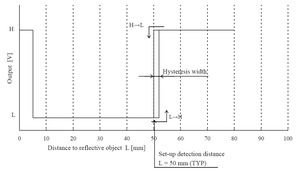 |
|
Sharp GP2Y0D805Z0F digital distance sensor 5 cm measuring characteristics. |
|---|
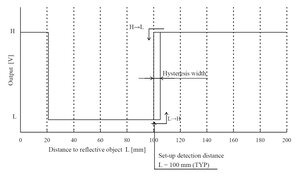 |
|
Sharp GP2Y0D810Z0F digital distance sensor 10 cm measuring characteristics. |
|---|
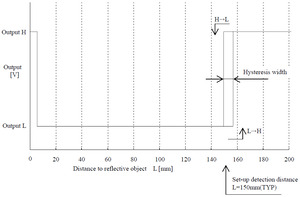 |
|
Sharp GP2Y0D815Z0F digital distance sensor 15 cm measuring characteristics. |
|---|
Some example applications include:
- break-beam sensor or photogate alternative
- non-contact bumper or obstacle detector
- a counter or timer of objects as they pass by
Using the sensor
The Pololu carrier board lets you interface with the GP2Y0D805, GP2Y0D810, or GP2Y0D815 sensor using a three-pin 0.1″ connector, such as the included 3×1 straight male header strip and 3×1 right-angle male header strip. You can connect to these pins with a servo cable or with a custom-made cable using pre-crimped wires and a 3×1 crimp connector housing.
The square pad is ground, the middle pad is VIN (2.7 – 6.2 V), and the remaining pad is the sensor output, OUT. Depending on your power source, you might notice an increase in performance by placing a large (>10 uF) capacitor between power and ground somewhere near the sensor.
A red LED on the back of the PCB lights when the output is low, indicating that the sensor is detecting something. With the LED in the circuit, the low output signal will be around 1 V. If so desired, you can disable this LED by cutting the trace between it and the OUT pin where it is marked on the silkscreen or by desoldering the LED, in which case the low voltage will be below 0.6 V.
The GP2Y0D805, GP2Y0D810, and GP2Y0D815 have an optional enable input that can be used to put the sensor into low-power mode. The Pololu carrier board connects this input to Vcc so that the sensor is always enabled, but you can solder a wire to the pad labeled “enable” on the back of the PCB if you want control over this input. Note that you will need to cut the trace that connects the enable line to Vcc on the PCB if you want to be able to disable the sensor. This trace is marked on the silkscreen, and there is a caret that indicates where we suggest you make the cut.
The carrier board has a 0.086″ mounting hole for a #2 or M2 screw. You can make the module more compact by cutting or grinding off this portion of the PCB if you do not need the mounting hole.
Feature summary
- Operating voltage: 2.7 V to 6.2 V
- Average current consumption: 5 mA (typical)
- Distance measuring range
- GP2Y0D805Z0F: 0.5 cm to 5 cm (0.2″ to 2″)
- GP2Y0D810Z0F: 2 cm to 10 cm (0.8″ to 4″)
- GP2Y0D815Z0F: 0.5 cm to 5 cm (0.2″ to 6″)
- Output type: digital signal (low when detecting an object, high otherwise)
- Steady state update period: 2.56 ms typical (3.77 ms max)
- Enable pad can optionally be used to disable the emitter and save power (this feature requires you to cut a trace first)
- Size without header pins: 21.6 mm × 8.9 mm × 10.4 mm (0.85″ × 0.35″ × 0.41″)
- Weight without header pins: 1.5 g (0.05 oz)
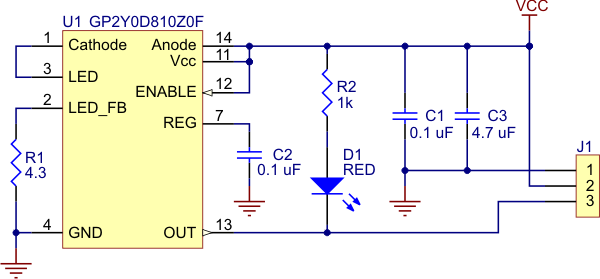 |
|
Pololu carrier for Sharp GP2Y0D805Z0F, GP2Y0D810Z0F, and GP2Y0D815Z0F sensors schematic diagram. |
|---|
Alternative Sharp distance sensors
We carry several analog Sharp distance sensors as well: the Sharp GP2Y0A51SK0F 2 – 15 cm, the Sharp GP2Y0A41SK0F 4 – 30 cm, the Sharp GP2Y0A21YK0F 10 – 80 cm, and the Sharp GP2Y0A02YK0F 20 – 150 cm. These analog distance sensors have longer minimum detection distances and much slower response times than the GP2Y0D805, GP2Y0D810, and GP2Y0D815, but they can see farther and report the distance to the detected object rather than simply if an object is detected.
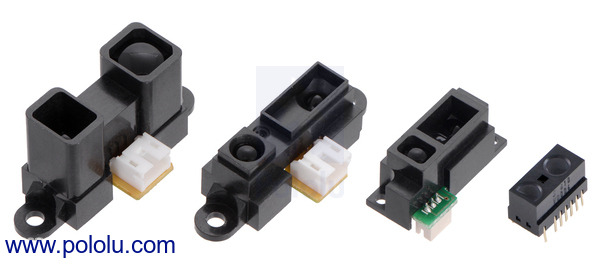 |
|
A variety of Sharp distance sensors. From left to right: GP2Y0A02, GP2Y0A21 or GP2Y0A41, GP2Y0A51, and GP2Y0D8xx. |
|---|
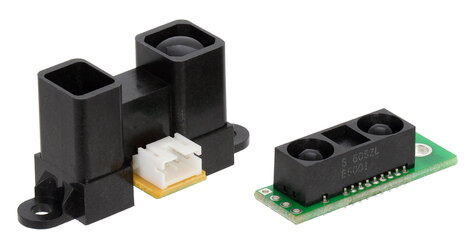 |
|
Sharp GP2Y0A02YK0F Sensor 20-150cm (left) next to Pololu Carrier with Sharp GP2Y0A60SZLF Sensor 10-150cm (right). |
|---|
Dimensions
| Size: | 0.85″ × 0.35″ × 0.41″1 |
|---|
General specifications
| Maximum range: | 15 cm |
|---|---|
| Minimum range: | 0.5 cm |
| Sampling rate: | 390 Hz2 |
| Minimum operating voltage: | 2.7 V |
| Maximum operating voltage: | 6.2 V |
| Supply current: | 5 mA3 |
| Output type: | digital4 |
Notes
1. Without included optional headers.
2. Typical; can be as low as 265 Hz.
3. Average; this sensor draws current in large, short bursts, so it might help to place 10 µF capacitor or larger across power and ground close to the sensor in some applications.
4. Low when detecting an object, high otherwise.




New Products
-

 Sold out
Sold outPixhawk 6X Pro FC
Vendor:HolybroRegular price Rs. 53,499.00Regular priceUnit price / per -
Pixhawk 6X (ICM-45686) FC
Vendor:HolybroRegular price Rs. 15,999.00Regular priceUnit price / per -
Pixhawk Jetson Baseboard
Vendor:HolybroRegular price Rs. 44,999.00Regular priceUnit price / per -
EZO-HUM™ Embedded Humidity Probe – Plastic Body
Vendor:Atlas ScientificRegular price Rs. 6,049.00Regular priceUnit price / per -
EZO Complete-Dissolved Oxygen™
Vendor:Atlas ScientificRegular price Rs. 14,799.00Regular priceUnit price / per -
EZO-O2™ Embedded Oxygen Sensor – Plastic Body
Vendor:Atlas ScientificRegular price Rs. 10,999.00Regular priceUnit price / per -
Crazyflie 2.1 Brushless
Vendor:BitcrazeRegular price Rs. 53,399.00Regular priceUnit price / per -
Propeller 47-17 (4CCW+4CW) (black)
Vendor:BitcrazeRegular price Rs. 699.00Regular priceUnit price / per -
Crazyflie 2.1+
Vendor:BitcrazeRegular price Rs. 26,499.00Regular priceUnit price / per -

 Sold out
Sold outWidowX Aloha Leader Arm
Vendor:Trossen RoboticsRegular price From Rs. 524,999.00Regular priceUnit price / per -
ViperX Aloha Follower Arm
Vendor:Trossen RoboticsRegular price From Rs. 749,999.00Regular priceUnit price / per -
Aloha Stationary
Vendor:Trossen RoboticsRegular price From Rs. 3,149,999.00Regular priceUnit price / per -
4P JST Expansion Board
Vendor:RobotisRegular price Rs. 749.00Regular priceUnit price / per -
Kakute H7 v1.3 Stacks +Tekko32 F4 4in1 50A ESC
Vendor:HolybroRegular price Rs. 18,029.00Regular priceUnit price / per -
Kakute H7 v1.3 (MPU6000)
Vendor:HolybroRegular price Rs. 10,279.00Regular priceUnit price / per -
Pixhawk 6C (Aluminum Case) + PM02 +M10 GPS
Vendor:HolybroRegular price Rs. 37,269.00Regular priceUnit price / per -
Pixhawk 6C (Aluminium Case) +PM02+M9N GPS
Vendor:HolybroRegular price Rs. 40,539.00Regular priceUnit price / per -
PM02 V3 Power Module (12S)
Vendor:HolybroRegular price Rs. 2,299.00Regular priceUnit price / per -
Pixhawk 6C (Aluminium Case)
Vendor:HolybroRegular price Rs. 31,099.00Regular priceUnit price / per -
Holybro Pixhawk 6X - Standard set + M9N(GPS V1.7)
Vendor:HolybroRegular price Rs. 46,469.00Regular priceUnit price / per -
Holybro Pixhawk 6X - Standard Set + M10(GPS V1.7)
Vendor:HolybroRegular price Rs. 42,999.00Regular priceUnit price / perRs. 43,099.00Sale price Rs. 42,999.00Sale -
Analog Discovery Pro ADP2230: Mixed Signal USB Oscilloscope, Waveform Generator, Logic Analyzer, and Variable Power Supply
Vendor:DigilentRegular price Rs. 74,999.00Regular priceUnit price / per -
2x12 Flywires: Signal Cable Assembly for the Analog Discovery Pro 3000 Series
Vendor:DigilentRegular price Rs. 999.00Regular priceUnit price / per















































